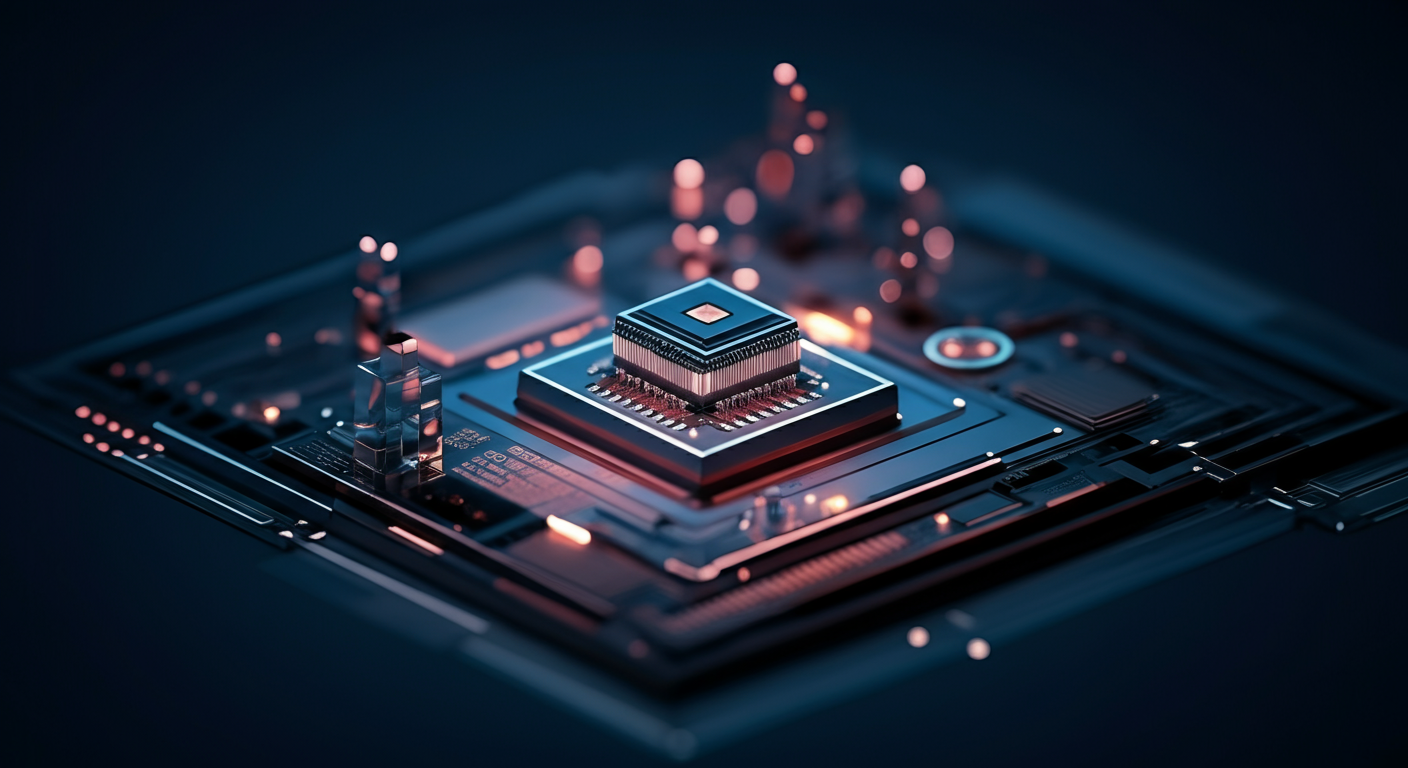On-Device AI Inference: Achieving Sub-Second Latency for Superior User Experiences

The Imperative of Speed: Why On-Device AI Inference Matters for UX
On-device AI inference is rapidly becoming a cornerstone of superior user experiences, offering a compelling alternative to cloud-based solutions.
Why On-Device Matters
On-device AI refers to running AI models directly on a user's device (smartphone, laptop, etc.) rather than relying on remote servers.
This approach dramatically reduces latency – the delay between a user's request and the AI's response. Its advantages include:
- Sub-Second Latency: Eliminating round-trip network delays leads to near-instantaneous responses, fostering a more fluid and engaging user experience. Think of ChatGPT responding instantly, even without an internet connection. ChatGPT is a conversational AI tool that can help users generate text, translate languages, and more.
- Enhanced Privacy: Sensitive data remains on the device, mitigating privacy risks associated with cloud transmission and storage.
- Increased Reliability: Functionality persists even in the absence of network connectivity, ensuring uninterrupted access to AI features.
- Reduced Costs: On-device inference eliminates the need for constant data transfer and cloud compute resources.
The Impact of Latency on User Engagement
Studies have shown a direct correlation between latency and user engagement. Even small delays can have a significant negative impact:
- Milliseconds Matter: Research suggests that delays as short as 100ms can noticeably impact user perception of responsiveness.
- Increased Abandonment: E-commerce sites have observed that page load delays of just a few seconds can lead to significant increases in abandonment rates.
Real-World Use Cases
Instant AI responses are crucial in various applications:
- Real-time Translation: Seamless language translation during conversations.
- Object Recognition: Immediate identification of objects in images or video streams.
- Personalized Recommendations: Instantaneous product or content recommendations based on user preferences.
In summary, embracing on-device AI inference is not just a technological upgrade, but a strategic imperative for building user-centric applications that deliver speed, privacy, and reliability. Continue learning about the fundamentals of AI in our Learn section.
Achieving sub-second latency for on-device AI inference requires careful architectural considerations.
Architecting for Speed: Optimizing the On-Device AI Stack

The on-device AI stack involves several layers, each crucial for achieving optimal performance: hardware, operating system, AI framework, and the model itself. Understanding these layers allows for targeted optimization strategies.
- Hardware Selection: Different hardware components, including CPUs, GPUs, NPUs, and specialized AI chips, offer varying performance characteristics. CPUs are general-purpose but may be slower for AI tasks. GPUs provide parallel processing capabilities, while NPUs are specifically designed for neural network computations. Benchmarking is essential to determine the best option.
- Operating System Optimization: Selecting the right operating system and kernel is key. A lightweight, real-time OS can minimize overhead and improve responsiveness for AI workloads.
- AI Framework Choices: Frameworks like TensorFlow Lite (Google's lightweight solution optimized for mobile and embedded devices) offer tools for model optimization and efficient inference. Others, such as Core ML, MediaPipe, and ONNX Runtime, each have pros and cons depending on your target platform and model architecture.
- Model Optimization Techniques: Model optimization techniques like quantization, pruning, distillation, and operator fusion are critical. These methods reduce model size and complexity, leading to faster inference times, however, they often come with trade-offs in accuracy. For example, model quantization reduces model size and increases speed by converting floating-point numbers to integers.
- Model Compression: Reducing model size is paramount. Techniques include model quantization, pruning (removing less important connections), and distillation (training a smaller model to mimic a larger one).
- Memory and Power Considerations: Mobile devices have limited resources. Effective memory management and power-saving techniques are essential for on-device AI.
By carefully selecting and tuning these components, developers can significantly improve the performance and user experience of on-device AI applications. Consider using tools from the Software Developer Tools category to facilitate this process.
Achieving optimal user experiences with on-device AI hinges on designing models that deliver sub-second latency.
Model Design for Efficiency: Balancing Accuracy and Performance
Deploying AI models directly on devices, rather than relying on cloud-based inference, offers significant advantages in speed and privacy. This requires careful model design that prioritizes efficiency.
Strategies for Lightweight AI Models
To achieve sub-second latency on resource-constrained devices, focus on lightweight AI models. These models are optimized for speed and memory efficiency, making them ideal for on-device deployment.
Consider factors like model size, computational complexity, and memory footprint.
Techniques for Reducing Model Complexity
- Efficient Neural Network Architectures: Explore architectures like MobileNet or SqueezeNet, designed for mobile devices, or even explore simpler alternatives like decision trees for less demanding tasks. These networks use techniques like depthwise separable convolutions to reduce the number of parameters and computations.
- Model Compression: Implement techniques like quantization, pruning, and knowledge distillation to reduce model size without significantly impacting accuracy. Consider using Neural Architecture Search (NAS) to automatically find the ideal model for your hardware. NAS automates the model design, to optimize for constraints like latency and power consumption.
Transfer Learning and Fine-Tuning
Leverage transfer learning by fine-tuning pre-trained models for your specific on-device tasks. This approach allows you to achieve high accuracy with limited data and reduced training time.
Data Augmentation and Synthetic Data
Address the challenge of limited data by employing data augmentation techniques. Additionally, explore synthetic data generation methods to expand your training dataset and improve the robustness of your on-device models.
By carefully balancing model complexity with accuracy, and leveraging techniques like transfer learning and data augmentation, you can design AI models that deliver exceptional user experiences on edge devices. This enables real-time insights and improved user experience in a way that cloud-based solutions simply cannot match.
Edge computing brings AI closer to the data source, enabling lightning-fast on-device AI inference and opening doors to superior user experiences.
The Core of Edge Computing
Edge computing, in the context of AI, involves processing data near the "edge" of the network—closer to where the data is generated, like on a user's device or a nearby edge server. This contrasts with traditional cloud computing, where data is sent to a remote data center for processing. On-device AI inference leverages this by running AI models directly on the device, minimizing latency and improving responsiveness.Enhancing On-Device AI with Edge
Edge computing elevates on-device AI in several ways:- Offloading Intensive Tasks: Some AI tasks, like initial data processing or complex model components, can be offloaded to edge servers. This creates a hybrid AI architecture where the device handles real-time inference, while the edge provides additional compute power.
- Improved Data Privacy: By processing sensitive data locally or within a trusted edge environment, edge computing reduces the need to transmit data to the cloud, strengthening data privacy and compliance.
- Reduced Latency: Edge computing dramatically reduces the round-trip time required for cloud processing, enabling real-time decision-making in applications like fraud detection or autonomous vehicles.
Architectural Considerations
Building edge-enabled AI applications requires careful planning:- Hybrid AI Architecture: Designing a system where tasks are intelligently divided between the device and the edge based on resource constraints and latency requirements.
- Edge Infrastructure: Choosing suitable edge infrastructure, such as local servers or fog computing platforms, that can handle AI workloads.
- Data Synchronization: Implementing mechanisms for synchronizing data between the device and the edge server when necessary.
Security at the Edge
Distributing AI workloads raises critical security concerns. Measures such as encryption, secure boot processes, and robust authentication mechanisms are vital to protect data and models at the edge.The key is to design a multi-layered security approach, distributing trust across the system to mitigate potential risks.
By strategically leveraging edge computing, businesses and developers can unlock the full potential of on-device AI, creating truly responsive, private, and intelligent applications. This blend of cloud and device intelligence paves the way for innovative solutions in fraud detection, predictive maintenance, and countless other fields. Looking for the right tool? Explore our AI Tool Directory.
Achieving sub-second latency with on-device AI inference is crucial for delivering seamless and responsive user experiences.
Case Studies: Real-World Examples of Low-Latency On-Device AI

Here are some examples of how companies are leveraging on-device AI to unlock new capabilities and deliver superior user experiences:
- Mobile Image Processing: Imagine real-time photo enhancement and object recognition directly on your smartphone. By performing inference on the device, companies like Google (using tools perhaps found on an AI Tool Directory), avoid the latency and bandwidth constraints of cloud-based processing, resulting in near-instantaneous results. Optimization techniques often include model quantization and efficient neural network architectures.
- Speech Recognition: Voice assistants like ChatGPT are becoming increasingly reliant on on-device speech recognition for faster command processing. This reduces round-trip times to servers, enabling quicker responses and improved user interaction, particularly in areas with limited network connectivity. Performance gains are quantified by measuring word error rate (WER) and response time.
- Wearable Devices: Smartwatches and fitness trackers utilize on-device AI for continuous health monitoring and activity tracking.
Quantifiable metrics include inference speed in milliseconds and power consumption in milliwatts.
- Autonomous Vehicles: Self-driving cars rely heavily on on-device AI for real-time perception and decision-making. Processing sensor data locally is essential for safety and responsiveness, enabling the vehicle to react instantly to changing road conditions. This is a hot topic discussed in many AI News.
- Innovative Use Cases: Low-latency on-device AI is pushing boundaries in fields like augmented reality (AR) and industrial automation. By processing information locally, AR applications can seamlessly overlay digital content onto the real world, while robotic systems can respond quickly to changing environments.
Achieving sub-second latency with on-device AI inference is becoming increasingly critical for delivering seamless and responsive user experiences.
Tools and Frameworks: Streamlining On-Device AI Development
Developers have a range of tools and frameworks to choose from when building and deploying AI models directly onto devices. Each tool offers a unique set of features, performance characteristics, and platform support.
- TensorFlow Lite: A popular open-source framework optimized for on-device machine learning, enabling efficient inference on mobile, embedded, and IoT devices. This makes TensorFlow Lite a versatile choice.
- Core ML: Apple's machine learning framework accelerates model execution on Apple devices (iOS, macOS, watchOS, and tvOS). Core ML offers seamless integration and optimized performance for Apple's ecosystem.
- Qualcomm Neural Processing SDK: This SDK leverages Qualcomm's Snapdragon Neural Processing Engine (NPE) to provide hardware-accelerated AI inference. Qualcomm's SDK can significantly boost AI performance on compatible devices.
- Arm NN: Designed for energy-efficient inference on Arm-based processors, Arm NN is ideal for mobile and embedded systems. By leveraging Arm NN, developers can optimize models for power-constrained devices.
Choosing the Right Tool
Selecting the optimal tool hinges on specific project requirements. Factors like ease of use, performance benchmarks, target platforms, and integration with existing workflows play crucial roles. Emerging tools are constantly reshaping the on-device AI landscape. Integrating these tools into existing CI/CD pipelines can further streamline development and deployment, optimizing AI workflows.
Future Trends: The Evolution of On-Device AI
On-device AI inference is poised to revolutionize user experiences with its promise of sub-second latency and enhanced privacy.
Hardware Advancements
Expect to see more powerful and energy-efficient chips designed specifically for AI tasks.- Neuromorphic computing: Inspired by the human brain, these chips promise faster and more efficient AI processing.
- Specialized NPUs (Neural Processing Units): These units are becoming standard in mobile devices, accelerating AI tasks like image recognition and natural language processing. Example: Apple's Neural Engine in iPhones.
Algorithmic Improvements
New algorithms will continue to make AI models smaller and faster.- Model Compression: Techniques like quantization and pruning reduce the size of AI models without sacrificing accuracy.
- Efficient Architectures: Architectures like MobileNet are designed for resource-constrained devices, enabling complex AI tasks on smartphones.
- Federated learning will also play a vital role, as highlighted in our piece on Federated Learning.
Convergence of AI and Emerging Tech
On-device AI will play a critical role in emerging technologies.- AR/VR: Real-time object recognition and scene understanding are crucial for immersive augmented and virtual reality experiences. Think AI-powered filters in AR apps. Also read more about AI and virtual reality (VR).
- 5G and IoT: 5G's high bandwidth and low latency will enable more sophisticated on-device AI applications. Consider the convergence of AI and IoT, explored in "Decoding South Korea's AI Revolution: Beyond OpenAI's Economic Influence".
Keywords
on-device AI, edge AI, AI inference, low latency AI, mobile AI, AI optimization, AI performance, real-time AI, AI models, TensorFlow Lite, Core ML, AI hardware, edge computing, AI user experience, sub-second latency
Hashtags
#OnDeviceAI #EdgeAI #MobileAI #AIInference #LowLatencyAI
Recommended AI tools

Your AI assistant for conversation, research, and productivity—now with apps and advanced voice features.

Bring your ideas to life: create realistic videos from text, images, or video with AI-powered Sora.

Your everyday Google AI assistant for creativity, research, and productivity

Accurate answers, powered by AI.

Open-weight, efficient AI models for advanced reasoning and research.

Generate on-brand AI images from text, sketches, or photos—fast, realistic, and ready for commercial use.
About the Author

Written by
Regina Lee
Regina Lee is a business economics expert and passionate AI enthusiast who bridges the gap between cutting-edge AI technology and practical business applications. With a background in economics and strategic consulting, she analyzes how AI tools transform industries, drive efficiency, and create competitive advantages. At Best AI Tools, Regina delivers in-depth analyses of AI's economic impact, ROI considerations, and strategic implementation insights for business leaders and decision-makers.
More from Regina

